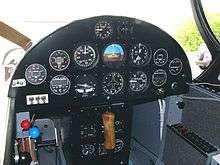Van's Aircraft RV-3
The Van's RV-3 is a single-seat, single-engine, low-wing kit aircraft sold by Van's Aircraft.[2] Unlike many other aircraft in the RV line, the RV-3 is only available as a tail-wheel equipped aircraft, although it is possible that some may have been completed by builders as nose-wheel versions. The RV-3 is the genesis design for the rest of the RV series, all which strongly resemble the RV-3. The RV-4 was originally developed as a two-seat RV-3.
| RV-3 | |
|---|---|
.jpg) | |
| Role | Kit aircraft |
| National origin | United States |
| Manufacturer | Van's Aircraft |
| Designer | Richard VanGrunsven |
| Introduction | 1971 |
| Status | RV-3: Production completed RV-3B: In production |
| Number built | 302 (April 2019)[1] |
| Unit cost |
USD$35,000–$63,000 |
| Developed from | Stits Playboy |


Development
The architect of the line of Van's aircraft, Richard VanGrunsven, designed the RV-3 in the late 1960s after experience flying the Stits Playboy amateur-built aircraft. The RV-3 started out as an attempt to maintain the Playboy's layout and concept but to improve it in every regard. The RV-3 was designed to have light handling, aerobatic capabilities, fast cruise speeds, and short field STOL capabilities. The RV-3 was also designed from the start for serious travel and as such carries 30 US gallons of fuel, giving it a range of about 600 statute miles. The design horsepower is 100–150, typically using a Lycoming O-235 or Lycoming O-320 powerplant. Some builders have fitted RV-3s with more powerful engines, however.
The RV-3 uses a NACA 23012 airfoil on a constant chord wing. Construction is semi-monocoque of predominantly 2024-T3 aluminum sheet. The wings are built around an aluminum I-beam spar with a lighter rear spar. The aircraft has plain flaps operated by a handle. The main landing gear is attached directly to the welded steel engine mount and consists of tapered, sprung steel tubes. Construction time for the RV-3 is reported to be 1300 hours for a first time builder.
The very first RV-3 built by VanGrunsven won "Best Aerodynamic Detailing" at the 1972 EAA Oshkosh Convention.
There is an RV-3A model, but its designation does not follow VanGrunsven's normal system, where "A" models are nosewheel equipped versions. An RV-3A is an early RV-3 that has undergone rear spar and wing root upgrades as described in Van's publication CN-1. Due to ongoing structural concerns, the production of RV-3 kits was suspended in 1996. Continued customer demand for the single seat design resulted in VanGrunsven engineering a new wing for the RV-3. Production of kits was restarted a few years later. New aircraft completed since the wing redesign and aircraft that have been retrofitted with the new wing are referred to as an RV-3B.
By April 2019, 302 RV-3s have been completed and flown.[1]
Aircraft on display
- Classic Flyers Museum – ZK-RVE, built from the first kit exported outside the US in 1976.
- EAA AirVenture Museum – RV-3 Prototype N17RV[3]
Specifications (RV-3B)

General characteristics
- Crew: one pilot
- Capacity: no passengers
- Length: 19 ft 0 in (5.79 m)
- Wingspan: 19 ft 11 in (6.07 m)
- Height: 5 ft 0 in (1.52 m)
- Wing area: 90 sq ft (8.4 m2)
- Empty weight: 750 lb (340 kg)
- Gross weight: 1,100 lb (499 kg)
- Max takeoff weight: 1,100 lb (499 kg)
- Powerplant: 1 × Lycoming O-320 fixed pitch, 150 hp (110 kW)
Performance
- Maximum speed: 207 mph (333 km/h, 180 kn) at sea level
- Stall speed: 51 mph (82 km/h, 44 kn)
- Range: 595 mi (958 km, 517 nmi) at cruise 75% power at 8,000 ft (2,500 m)
- Service ceiling: 23,500 ft (7,200 m)
- Rate of climb: 2,050 ft/min (10.4 m/s)
- Wing loading: 12.2 lb/sq ft (60 kg/m2)
See also
Related development
Aircraft of comparable role, configuration and era
References
- Vans Aircraft (April 2019). "First Flights". Retrieved 13 April 2019.
- Vandermeullen, Richard: 2012 Kit Aircraft Buyer's Guide, Kitplanes, Volume 28, Number 12, December 2011, page 74. Belvoir Publications. ISSN 0891-1851
- EAA AirVenture Museum (2012). "Van Grunsven RV-3 Prototype – N17RV". Retrieved 11 May 2012.
- Van's Aircraft Website
- Armstrong, Kenneth, Choosing Your Homebuilt – The One You'll Finish And Fly, Butterfield Press, Templeton CA 1993.
- Bowers, Peter M, Guide to Homebuilts 9th Edition, TAB Books Blue Ridge Summit PA, 1984.
- Plane and Pilot, 1978 Aircraft Directory, Werner and Werner, Santa Monica CA 1978